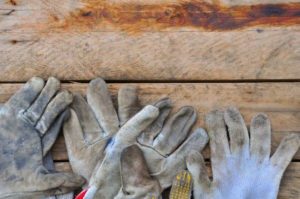Written by: Shepard Law Firm Staff
Most people would be surprised to know that there are a significant number of people who have developed asbestos-related illnesses without working with or around asbestos or asbestos-containing products. Most of these cases involve the spouse or family member of someone who worked with asbestos-containing products. But how did these household members, who never personally worked with asbestos-containing products, get exposed to asbestos dust?
The danger of asbestos arises when asbestos fibers are released into the air and are then breathed into the human body. This typically occurs when asbestos-containing products are repaired and replaced. For instance, when an old asbestos-containing gasket is scraped from a pipe flange, that scraping process releases asbestos-containing dust into the air. In most asbestos cases, the injured person is the worker, who breathes in this dust while personally doing the work.
Unfortunately, that is not the only risk created by asbestos-containing products. The dust from an asbestos-containing product can also get on the clothing of the person doing the work, as well as on the clothing of any individual who is working in the near vicinity. This dust can stay on the worker’s clothing for long periods of time, and when the worker wears his or her dirty work clothing home, the dust can come along for the ride.

Anyone who has done laundry before understands the typical process for washing dirty and dusty clothing. Instead of placing these dirty and dusty clothes directly in the washing machine, most people shake out these clothes in order to get all the dust off of them. Shaking out dirty work clothing creates dust that gets breathed in by the person doing the shaking, as well as by those who are in the area helping out with the laundry. And if the person who wore those dirty clothes worked with or around asbestos-containing products, the dust on those clothes could contain asbestos. We have seen many mesothelioma cases where the injured person’s only exposure to asbestos came from laundering dirty work clothing. This type of exposure to asbestos is called “take home” exposure and doing laundry is one of the more common sources. From an emotional standpoint, these cases are very disheartening, and usually come as a complete shock to families.
These cases also differ from the typical asbestos cases in how the evidence of exposure is put together. The most important part of an asbestos case is product identification. The Plaintiff or injured person has to prove they were exposed to asbestos from certain products. Typically, it is the injured person who will identify from which products he or she was exposed to asbestos. However, in “take home” exposure cases, the injured person is someone who didn’t work with asbestos products, and is unlikely to know which products they might have been exposed to. Therefore, in “take home” exposure cases, the more knowledgeable witness, with regard to product identification, is usually the spouse or household member who actually worked with the asbestos products and brought asbestos dust home on their work clothing. The spouse or household member can testify about the work he or she did with asbestos or asbestos-containing products and the condition of their work clothing when it was worn home. This evidence, combined with testimony that the injured person laundered the dirty work clothing, is sufficient to satisfy the requirements of product identification.
Unfortunately, these types of cases have become much more common in recent years. Our firm has handled many of these cases, and has the knowledge and experience needed to succeed in this complex area of litigation.
If you or a loved one has been diagnosed with an asbestos-related illness like mesothelioma or lung cancer, and would like to know more about your rights, please call us for a free, confidential consultation at (617) 451-9191.